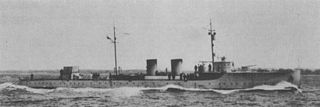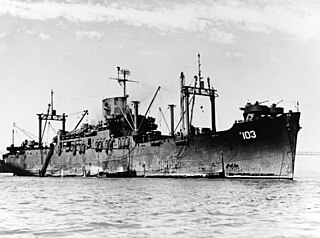Related Research Articles
USS Captor (PYc-40), briefly the seventh ship to bear the name USS Eagle (AM-132), was a Q-ship of the United States Navy.

USS Impetuous (PYc-46) was a private yacht purchased by the Navy in August 1940 that served as a patrol boat of the United States Navy in Central America. The yacht was built as Paragon, the first of at least two Davol yachts to bear the name, in 1915 for Charles J. Davol of Providence, Rhode Island. In 1916 Davol sold the yacht to John Fred Betz, 3d of Philadelphia who renamed the yacht Sybilla III which served as the Section Patrol yacht USS Sybilla III (SP-104) from May 1917 to December 1918. Sybilla III remained in Betz's ownership until sale in 1935 to R. Livingston Sullivan of Philadelphia who renamed the yacht Arlis. On 12 August 1940 the Navy purchased the yacht placing it in commission as USS PC-454 on 16 October. The vessel was given the name Impetuous and reclassified PYc-46 on 15 July 1943. The yacht was decommissioned at Philadelphia 31 August 1944 and transferred to the War Shipping Administration for sale.
The second USS Sapphire (PYc-2) was a patrol boat in the United States Navy.
USS Amethyst (PYc-3) was the yacht Samona II taken into service in the United States Navy serving as a patrol boat during World War II. After military service the vessel was returned to civilian status in 1946 and again became the yacht Samona II until sale and subsequent names of Pudlo and Explorer.

USS Onyx (PYc-5), was a diesel coastal patrol yacht of the United States Navy during World War II.

USS Amber (PYc-6) was a patrol boat in the United States Navy during World War II, built at Long Beach, California in 1930 as the yacht Infanta for the actor John Barrymore.

USS Winchester (SP-156) was an armed yacht that served in the United States Navy as a patrol vessel from 1917 to 1919. Prior to and following World War I, Winchester was a private yacht, later renamed Renard. In World War II, Renard was requisitioned for use in the Royal Canadian Navy as a patrol vessel, keeping her name. She was returned to her owners in 1944.

USS Roamer (AF-19) was the Danish refrigerated motorship African Reefer, completed 1935, of the J. Lauritzen shipping company which had put in at Madeira after Germany occupied Denmark. The ship later sailed to a U.S. port on assurances it would be treated equally with U.S. vessels chartered for war purposes. Instead it was seized by the United States Maritime Commission and placed in service under War Shipping Administration (WSA) allotment to commercial, Army transport and finally Navy use at half the rate paid for U.S. ships. The agreed to rate was not restored until 1958 after a Supreme Court judgement and Congressional action.

USS Goldcrest (AM-78) was a minesweeper acquired by the U.S. Navy for the dangerous task of removing mines from minefields laid in the water to prevent ships from passing.
USS Victor (AMc-109) was an Accentor-class coastal minesweeper acquired by the U.S. Navy for the dangerous task of removing mines from minefields laid in the water to prevent ships from passing.
USS Leader (PYc-42) was a Leader-class patrol boat acquired by the U.S. Navy for the task of patrolling coastal areas during World War II when there was the danger of enemy submarine activity.
USS Venture (PC-826/PYc-51) was a patrol boat acquired by the U.S. Navy for the task of patrolling the coastal waters of the New York coast during World War II. Her primary task was to guard the coastal area against German submarines. For this reason, she carried depth charges.

USS President Polk (AP-103) was a President Jackson-class attack transport in the service of the United States Navy during World War II.

USS Crystal (PY-25), built in 1929 as the yacht Cambriona for Walter O. Briggs of Detroit, Michigan, was a patrol yacht in the United States Navy. The Navy acquired the yacht in January 1942 as Vida commissioning the vessel as Crystal in February. Naval service was in Hawaii until November 1945. After sale in November 1947 the vessel operated commercially in Central and South America.

USS Majaba (AG-43/IX-102) was the Design 1049 cargo ship Meriden built in 1919 by the Albina Engine & Machine Works, Portland, Oregon. All the ships were requisitioned by the United States Shipping Board (USSB) for World War I service. The ship was bought by the E. K. Wood Lumber Co., of San Francisco, California in 1923 and renamed El Capitan. The ship was chartered by the U.S. Navy through the War Shipping Administration (WSA) in April 1942 and commissioned as Majaba.
USS Sardonyx (PYc-12), formerly the yacht named Queen Anne (1928), was a patrol boat in the United States Navy during World War II.

The USS Alabaster (PYc-21) was a coastal patrol yacht of the United States Navy during World War II.

USS Valiant (PYc-51), originally USS PC-509, was a United States Navy patrol vessel in commission from 1941 to 1944.
USS Topaz (PYc-10) was a coastal patrol yacht in the service of the United States Navy. She was named for the gemstone Topaz.
USS Truant (PYc-14) was a coastal patrol yacht in the service of the United States Navy.
References
- ↑ Tolentino de Nóbrega (12 de dezembro de 2013). «Temporal na Madeira afundou antigo iate dos Beatles». Público. Consultado em 2 de dezembro de 2018